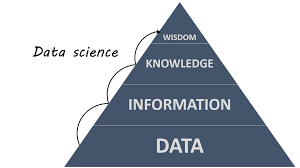The post How people use data modeling with advantages in everyday life? appeared first on Magnimind Academy.
]]>To get a clear overview of data modeling, you can think of a sales transaction which is broken down into associated groups of data points that describe the seller, the customer, the product sold, and the related payment method. While these qualities actually exist in the real world, have to be described systematically and clearly in order to be stored and retrieved perfectly from a database. Organizations also use data modeling to ensure that they’re capturing all the required items of information accurately. In the case of the previous example, if the transaction was recorded without any mention of the date of its occurrence, it’d be impossible to execute certain return policies. With the help of a data model, companies collect all the points of the necessary information in order to perform business operations and enforce policies based on the data they capture.
1- Why businesses use data modeling?
![]()
Similar to the building plan of an architect, data modeling helps organizations to develop a conceptual model and associations between data items. The primary goals of using data modeling include:
- Designing the database at the logical, physical, and conceptual level.
- Ensuring that every data object needed by the database is accurately represented. Exclusion of data will result in the development of faulty reports and generate incorrect results.
- Getting help in identifying redundant and missing data.
- Defining the relational tables, foreign and primary keys, and stored procedures.
- Getting a clear view of the base data which can be used to develop a physical database.
2- Different stages of data modeling
![]()
To obtain a clear understanding of data modeling, it’s important to learn how data models are used in practice. Three fundamental styles of data models are used.
- Conceptual model: This is the initial step in the data modeling process and defines what needs to be present in the model’s structure to define and organize business-oriented concepts. Mainly, it focuses on business-oriented attributes, entries, and relation. Basically, it’s designed by business stakeholders and data architects. Let’s have a look at the key characteristics of this model.
- Provides company-wide coverage of different business concepts.
- This model is created independently of hardware specifications such as data storage location, capacity, or software specifications such as technology and DBMS vendor.
- These models are developed and designed for a business audience.
- Logical model: The logical modeling process takes the semantic structure developed in the previous stage and attempts to implement order by establishing separate key values, relationships, and entities in a logical structure. Usually, this model is designed by data architects and business analysts. Key characteristics of this model include the following.
- Developed and designed independently from the DBMS.
- Describes data requirements for a single project but can be integrated with other logical models based on the project’s scope.
- Data attributes come with exact length and precisions.
- Physical model: This model describes how to implement the data model using a specific DBMS (Database Management System). Here, the data is broken down into actual clusters, indexes, and tables in order to be stored. This stage is created by developers and database administrators. Key characteristics of the physical model are,
- It consists of relationships between tables that address nullability and cardinality of those relationships.
- Developed for a certain version of a location, DBMS, technology or data storage to be used in the project.
- Foreign and primary keys, indexes, access profiles and authorizations, views etc are defined.
- Columns should contain exact lengths assigned, datatypes, and default values.
3- Different types of data models
![]()
While data modeling revolves around different approaches, the fundamental concept remains unchanged for all sorts of models. Let’s have a quick look at some of the most commonly used data models.
3.1- Entity-relationship model
![]()
This is one of the primarily used models these days. As the name suggests, it’s a graphical presentation of entities together with their relationships. An entity can be referred to as an object, a piece of data, or a concept.
3.2- Object-oriented database model
![]()
This model contains a collection of objects which have associated methods and features. Different types of object-oriented databases are used like the hypertext database, the multimedia database, and more. This kind of a model is also referred to as a post-relational database model as it’s not limited to tables even though it contains them.
3.3- Object-relational model
![]()
It can be considered as a relational model with the object-oriented database model’s advanced functionality. With this type of model, the functions can be incorporated into the familiar table structure by the designers.
3.4- Hierarchical model
![]()
In this model, each of the records comes with a single parent or root. They’re sorted in a specific order in the event of sibling records and that order is used as the physical order to store database.
3.5- Relational model
![]()
In a relational model, data segments are combined explicitly with the help of tables. Though this model has lowered program complexity, it needs a detailed understanding of the organization’s physical data storage.
4- Key advantages of data modeling from the aspect of data science

In the domain of data science, data modeling is widely used as a core concept when it comes to handling massive amounts of data. Let’s have a look at its most crucial benefits that businesses can leverage in this age of data science.
4.1- Designing databases and repositories
![]()
Data modeling plays a crucial role in designing a well-operating database, which is the primary goal of initiating a data modeling project. By modeling their data, businesses can make better decisions about data repositories and warehousing. Having a clear view of the data can tell them whether they need an independent data mart, a global warehouse, or a chain of interconnected data marts.
4.2- Integrating existing information systems
![]()
Many businesses sometimes find themselves in a situation where they’ve data in an array of systems that don’t communicate with each other. By doing data modeling in each of those systems, they can see redundancies and relationships, resolve discrepancies, and integrate dissimilar systems so that they can perform together.
4.3- Improved business intelligence
![]()
When a business has completed requirements gathering and merging of data from different sources together with query and reporting requirements, it becomes able to identify business intelligence opportunities which were nonexistent earlier or in haphazardly-designed databases. Using proper data modeling together with reporting, businesses can spot spending patterns, trends, and make predictions which will help them navigate opportunities and challenges.
4.4- Improved business understanding
![]()
The process of data modeling needs a company to understand in detail how the business operates in order to successfully define the data which drives it. For example, to develop a customer base, it needs to understand what data is captured on consumers and how it’s used. The data and the relationships represented in a model offer a foundation, based on which a business can develop an improved understanding of its business processes.
4.5- Knowledge transfer
![]()
Data modeling can be considered a type of documentation, both for technical experts and business stakeholders. Starting with offering a common vocabulary that can be shared by different job roles, and continuing on to giving newcomers a well-thought-out business glossary, a business’s ability to document and convey operational information is greatly enhanced.
5- Real-life examples where data modeling plays a crucial role

Regardless of whether people realize it or not, a wide range of activities of our everyday life is heavily influenced by data modeling. Here’re some of the most well-known examples.
5.1- Personal cloud storage
![]()
If you save documents or images to your tablet or smartphone, it’s likely that the data is stored in the cloud which is a massive, central storage environment that dedicates a small portion to you. Syncing this data across the devices needs the ability of powerful databases to call up the data whenever you need it, from anywhere.
5.2- Social media
![]()
Every social media platform stores a huge amount of user data in databases utilized to recommend friends, topics, products and businesses to the end user. This method of cross-referencing is extremely complicated and uses highly capable and reliable database software.
Final Takeaway

In almost every case, data science professionals in the real world end up using complex data sources as a regular part of their work. Having a solid understanding of how to apply data modeling techniques which enable those systems to record the real world’s picture is immensely crucial to leverage the abilities of big data.
. . .
To learn more about data science, click here and read our another article.
The post How people use data modeling with advantages in everyday life? appeared first on Magnimind Academy.
]]>